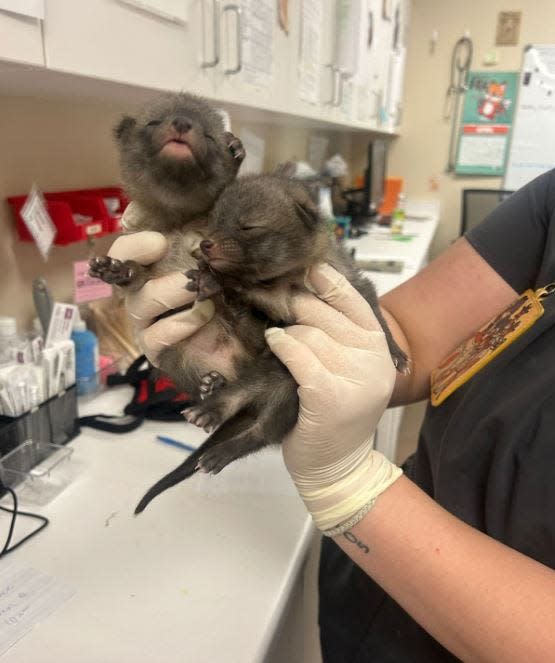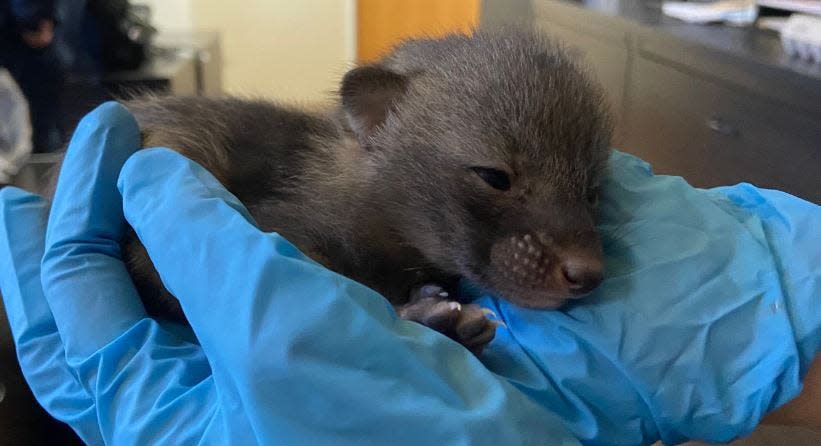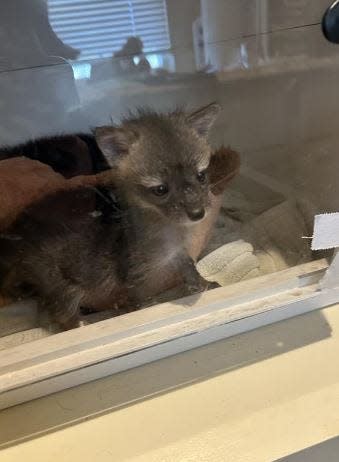Kittens or kits? Arizona resident mistakes foxes for cats, 'kit-naps' them

While rescuing a stray kitten or two may seem like a no-brainer, its not always a good idea.
Especially, if the kittens you find behind your shed aren’t really kittens at all.
A Phoenix resident turned the kittens they found in late April over to Arizona Humane Society, who completed a full medical examination and determined that these kittens, were in fact kits, Jennifer Armbruster, Humane Society spokesperson shared with USA TODAY.
They were able to determine pretty quickly that these kitten-looking creatures weren’t your run-of-the-mill domestic pets. The pair were later identified as a gray foxes.
"And it turned out they were gray foxes, which didn't surprise me — they both look like brown blobs when they're little," Kim Carr, an animal care manager at SWCC, told ABC15.
These kits are currently in the care of the Southwest Wildlife Conservation Center, a non-profit organization that is dedicated to the rescue, rehabilitation, and release of injured and orphaned wildlife.
“They will undergo rehabilitation and released to the wild when they are old enough to be on their own. This story also serves as an important reminder that animal mothers offer the best chance of survival for little ones like these,” Armbruster said.
‘Baby’ szn officially underway, increase in seemingly abandoned animals

Carr says that they typically care for hundreds of wild animals, including kits and javelinas, throughout the summer months.
“Right is kind of the beginning of what we call baby season. Wild animals, depending on the species, start having their babies March, April, May, or June. Sometimes they’ll have them throughout the summer,” Carr said.
Carr says the time period is always “pretty intense” because they never know how many wild animals they will ultimately be caring for. The kits, though, are the organization’s first official babies of the season. It might be tempting to take kittens, or wild animals that resemble kittens, but its probably best if you don’t.
“We want people we want people to contact us or their local rehab center … because nine out of 10 times they do not need to be rescued,” Carr said. These animal moms are usually out hunting or looking for food, leaving her babies for long periods of time.
Taking them from away from their home while the mom is out is akin to kidnapping, which is not good because “wild moms are just as protective of their babies as we are of our own children.”
The Arizona Humane Society echoes the sentiment, writing that “human intervention is typically not required.”
“In fact, the best thing we can do is leave the kittens alone. Mom will likely return shortly, and it’s critical that the kittens remain in her care as she offers the best chance for survival.”
If the mom hasn’t returned in eight hours, then it's very likely that the kittens, or wild animal question has been abandoned.
Kits will be released, they need to ‘stay wild’

It might be a little tough to wrap your head around the existence of gray foxes in the desert, but Carr says they’re actually the most common type of fox in Arizona.
“People think that’s really weird. They’re like ‘I have never seen gray foxes.’ They are out there and they’re even in urban areas,” Carr said.
They also happen to be very adaptable creatures, eating anything and everything they can find to survive. They also like to climb things, just like cats. The unnamed kits are in good health, consuming fox soup with their “needle sharp little teeth.”
Fox soup is a special concoction made with a mixture of formula, apple sauce, baby food, berries, meat, chopped up mice, according to Carr.
Carr says they are preparing the animals for release, waiting for them to get “big enough” and “display some pretty wild behaviors.”
“We will a really great suitable habitat for them, with a water source, lots of food, and trees. Then they’ll be released,” Carr said. They haven’t named the siblings, who are both boys, in an attempt to keep them as wild as possible.
But she can say that one has a more dominant and wild personality, known for jumping and wrestling with his brother. While the other has a more common denominator.
“It's kind of interesting to see how they evolve and see their different personalities … [But] foxes are one of those animals that can kind of lose their fear of people really quickly so we definitely doing everything in our power to keep them wild.”
This article originally appeared on USA TODAY: Baby foxes mistaken for kittens, mistakenly brought to Arizona rescue

